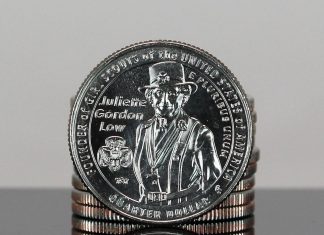The United States Mint began the new year with the release of 2010 Native American $1 coins through its Direct Ship Program. The offering replaced the 2009 $1 rolls featuring the same Sacagawea obverse but with the older themed "Three Sisters" planting design on the reverse.

The 2010 design features the new reverse theme, "Government – The Great Tree of Peace." It shows a Hiawatha Belt with five arrows bound together. The belt signifies the creation of the Haudenosaunee, also known as the Iroquois Confederacy.
In the center of the belt is a white pine that symbolizes the Onondaga Nation with the remaining four characters signifying the other nations that were part of the Confederacy, the Mohawk, Oneida, Cayuga and Seneca. Designed by Thomas Cleveland, the bundle of arrows show the strength in unity of the five participating nations.
Under the Direct Ship Program, the US Mint offers boxes of ten 25-coin rolls of the Native American strikes at their face value of $250. (See Circulating $1 Coin Direct Ship Rolls for more information or to place orders.) No premiums are added, and shipping costs are excluded. By way of an explanation for the seemingly generous program, the Mint states the following on their website:
The intended purpose of the Circulating $1 Coin Direct Ship Program is to make $1 Coins readily available to the public, at no additional cost, so they can be easily introduced into circulation — particularly by using them for retail transactions, vending, and mass transit. Increased circulation of $1 Coins saves the Nation money.
There is a 20-box household limit in place.
An interesting story involving the $1 coins and the Mint’s Direct Ship Program was featured on The Wall Street Journal just weeks ago. Scott McCartney writes how individuals had ordered thousands of the coins as a means to build up frequent flyer miles or other credit card rewards. When the rolls came, they were immediately exchanged for cash at banks. The US Mint now states on direct ship product page:
"The immediate bank deposit of $1 Coins ordered through this Program does not result in their introduction into circulation and, therefore, does not comply with the intended purpose of the Program."
Additionally, in bolded red under the order button it has added: "By clicking ‘Add to Cart’ I agree that I understand, and will comply with, the intended purpose of the Program."
The US Mint will be selling 25-coin rolls of 2010-P and 2010-D $1 coins to collectors on Jan. 22, 2010, for $32.95 per roll.
For more information this year’s design, to include specifications, see: 2010 Native American $1 Coin.
As dictated by the Native American $1 Coin Act (Public Law 110-82), the reverse of coins feature a different reverse design annually (beginning in 2009) that contain "images celebrating the important contributions made by Indian tribes and individual Native Americans to the development of the United States and the history of the United States."
In an interesting side note, the US Mint has also added 2001 Sacagawea Golden Dollars to its Direct Ship Program. The price is the same as the other $1 coins, but the order limit is set at 2 boxes, or 500 coins.






Looks nice, i’ll have to order some.
This is awesome; as a member Seneca; I am honored.
I will have to place an order.
What a coincidence – they’re using our wampum as their wampum. what’s next – our sovereignty?
I like the reverse design, but I wish the date would be restored to the obverse. At least to me, the front now looks unbalanced because the other elements’ positions are unchanged from the 2000-2008 series.
And at the risk of sounding cynical, if the US *really* wanted to save money the BEP would stop making $1 bills! Canada, the UK, Australia, New Zealand, and the EU have all managed to do the equivalent with their currencies. That’s almost three-quarters of a billion people who get through every day with coins instead of bills, but somehow we Americans can’t adapt.